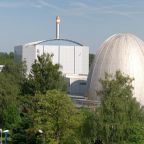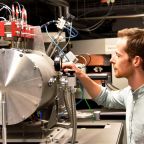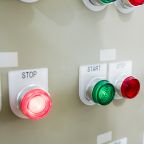Search results

Research reactors differ considerably in design and use from commercial reactors in nuclear power plants. GRS researchers are looking at how these differences affect the safety of research reactors.

In a joint project, researchers from various German institutions have taken a close look at the passive safety systems of nuclear power plants. The results have now been published in the report EASY Integral experimental and analytical investigations regarding the controllability of design basis accidents with passive systems. In addition to GRS, the following institutions were involved: the RWTH Aachen University, the Technische Universität Dresden, the Deggendorf Institute of Technology and FRAMATOME GmbH.
To ensure the safe operation of technical installations such as nuclear power plants (NPPs), it is important to continuously identify and analyse possible risk factors. In addition to technical safety, the so-called human factor, i.e. human influence and contribution, is of crucial importance for the safe operation of installations. Human-organisational aspects are therefore an aspect of safety research that should not be underestimated. In a recent study, GRS scientists have identified organisational factors that can have a negative influence on plant safety. These are specific characteristics that affect the structure of the organisation (organisational structure), the organisation of activities and processes (process organisation), and the corporate culture.

The mineral graphite is used in some types of reactors and can be activated by neutron radiation, i.e. converted into radioactive isotopes. In order to select a suitable disposal option, the graphite must be thoroughly examined radiologically. However, many measuring methods are relatively costly and in turn produce new radioactive waste themselves. A team of researchers from GRS and the University of Cologne is therefore developing a method with which reactor graphite can be characterised quickly and reliably.

When a nuclear power plant is finally shut down and no electricity is fed into the supply grid any longer, the so-called post-operational phase begins. This can take several years and ends when the licence holder receives from the competent supervisory authority a licence for the decommissioning and dismantling of the nuclear power plant. During the post-operational phase, the licence holder, in coordination with the competent supervisory authority, can already make preparations for the dismantling of the plant. Currently, there are three plants in post-operation in Germany.
GRS develops computer codes that allow the simulation of processes in a repository for radioactive waste and in the overburden of a repository.
For a long-term assessment of the safety of final repositories for radioactive waste, the program package RepoTREND (Transport and REtention of Non-decaying and Decaying contaminants in a final REPOsitory) is being developed and applied by GRS. In this program package, all relevant processes which contribute to the mobilisation and release of contaminants from the repository, transport through the host rock and adjacent rock formations as well as exposure in the biosphere have been implemented.
In Germany, the intention is to dispose of high-level radioactive waste in deep geological formations. The aim is to safely isolate the waste in an area within a host rock or in an area covered by a host rock. Host rock types may be rock salt, clay or crystalline rock (e.g. granite). By its containment, the waste is intended to be kept isolated from humans and the environment for a period of one million years.
For repository search and design, it is important to have a good understanding of the geology of a possible site and the processes that take place in the host rock. In Germany, the three potential host rocks for disposal are salt, clay and crystalline rocks (e.g. granite). The term deep underground gives the impression of being rigid and inactive. Only a closer look reveals the diverse chemical, mechanical and hydraulic processes that play a role in the underground.
Together with the Federal Institute for Geosciences and Natural Resources (BGR), DBE TECHNOLOGY GmbH, and the Fraunhofer Institute for Factory Operation and Automation (IFF), GRS has developed a new tool for repository research: the virtual underground laboratory VIRTUS.